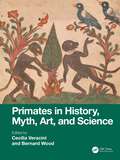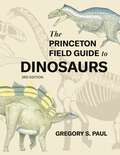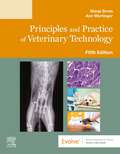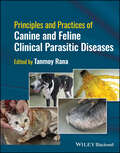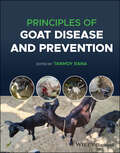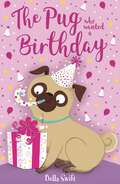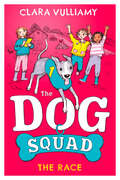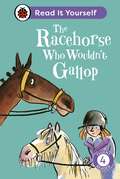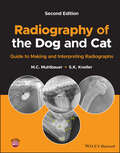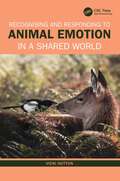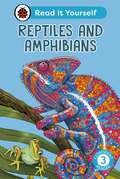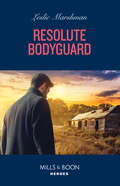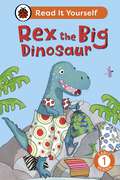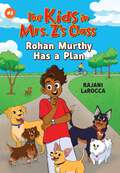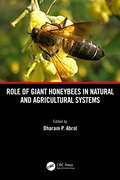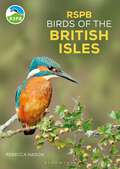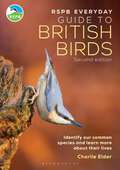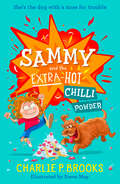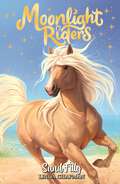- Table View
- List View
Primates in History, Myth, Art, and Science
by Cecilia Veracini Bernard WoodNon-human primates (hereafter just primates) play a special role in human societies, especially in regions where modern humans and primates co-exist. Primates feature in myths and legends and in traditional indigenous knowledge. Explorers observed them in the wild and brought them, at great cost, to Europe. There they were valued as pets and for display, their images featured in art and architecture, and where they were literally teased apart by scientists. The international team of contributors to this book draws these different perspectives together to show how primates helped humans better understand their own place in nature. The book will be of interest to undergraduate and graduate students as well scholars in disciplines ranging from anthropology to art history.Key features: Includes contributions from an international team of historians and natural scientists Integrates various perspectives and perceptions of non-human primates across time and place Summarizes the place of non-human primates in science, art and culture Includes rare early illustrations
Primates in History, Myth, Art, and Science
by Cecilia Veracini Bernard WoodNon-human primates (hereafter just primates) play a special role in human societies, especially in regions where modern humans and primates co-exist. Primates feature in myths and legends and in traditional indigenous knowledge. Explorers observed them in the wild and brought them, at great cost, to Europe. There they were valued as pets and for display, their images featured in art and architecture, and where they were literally teased apart by scientists. The international team of contributors to this book draws these different perspectives together to show how primates helped humans better understand their own place in nature. The book will be of interest to undergraduate and graduate students as well scholars in disciplines ranging from anthropology to art history.Key features: Includes contributions from an international team of historians and natural scientists Integrates various perspectives and perceptions of non-human primates across time and place Summarizes the place of non-human primates in science, art and culture Includes rare early illustrations
The Princeton Field Guide to Dinosaurs Third Edition (Princeton Field Guides #69)
by Gregory S. PaulA fully updated and expanded edition of the acclaimed, bestselling dinosaur field guideThe bestselling Princeton Field Guide to Dinosaurs remains the must-have book for anyone who loves dinosaurs, from amateur enthusiasts to professional paleontologists. Now extensively revised and expanded, this dazzlingly illustrated large-format edition features nearly 100 new dinosaur species and hundreds of new and updated illustrations, bringing readers up to the minute on the latest discoveries and research that are radically transforming what we know about dinosaurs and their world.Written and illustrated by acclaimed dinosaur expert Gregory Paul, this stunningly beautiful book includes detailed species accounts of all the major dinosaur groups as well as a wealth of breathtaking images—skeletal drawings, &“life&” studies, scenic views, and other illustrations that depict the full range of dinosaurs, from small feathered creatures to whale-sized supersauropods. Paul&’s extensive introduction delves into dinosaur history and biology, the extinction of nonavian dinosaurs, the origin of birds, and the history of dinosaur paleontology, and also gives a taste of what it might be like to travel back in time to the era when dinosaurs roamed the earth.Now covers more than 800 dinosaur species, including scores of newly discovered onesProvides startling perspectives on the famed Brontosaurus and TyrannosaurusReveals that the largest dinosaurs weighed as much as the biggest whales, and shows why that happenedFeatures hundreds of color and black-and-white drawings and figures, including life studies, scenic views, and skull and muscle drawingsIncludes color paleo-distribution maps and a color time lineDescribes anatomy, physiology, locomotion, reproduction, and growth of dinosaurs, as well as the origin of birds and the extinction of nonavian dinosaurs
Principles and Practice of Veterinary Technology - E-Book
by Ann WortingerDevelop strong critical thinking and independent work skills! Principles and Practice of Veterinary Technology, 5th Edition features more than 80 illustrated, step-by-step procedures that emphasize the technician’s roles and responsibilities for all AVMA-required psychomotor techniques. This edition includes expanded coverage of complementary medicine, critical care, pet health insurance, and toxicology. Plus, dozens of summary tables and boxes make it easy to find key information. Step-by-step procedures include instructions for all AVMA-required psychomotor techniques, presenting complex procedures clearly and preparing you to master the essential skills required to become a successful veterinary technician. Clinical discussions clearly delineate the technician’s role, enabling you to focus on your roles and responsibilities in every aspect of practice. Summary tables and boxes throughout the text condense complex, vital information, drawing your attention to key information and making it easy to understand. Thoroughly updated content throughout, including major updates to anesthesia, pain management, critical care, and infectious disease, provides the most up-to-date information in these critical areas.
Principles and Practices of Canine and Feline Clinical Parasitic Diseases
by Tanmoy RanaPrinciples and Practices of Canine and Feline Clinical Parasitic Diseases A comprehensive reference guide for specialists highlighting the parasitic diseases of dogs and cats with appropriate therapeutic strategy Parasitic diseases are a scourge for dogs and cats, and the impact of the numerous maladies associated with these diseases cannot be underestimated. For the clinician or researcher attempting to alleviate these symptoms, Principles and Practices of Canine and Feline Clinical Parasitic Diseases is a helpful, introductory practical guidebook that helps identify the parasites infecting these animals and suggests useful treatment strategies based on an appropriate diagnosis. Principles and Practices of Canine and Feline Clinical Parasitic Diseases comprehensively details its topic from symbiosis and parasitism, to therapeutics measures and control strategies, to the deleterious effect of parasites in various organs in dogs and cats. The book offers extensive information on management approaches, the most significant clinical findings, diagnostic approaches, disease prevention, and drug evaluation. As a reference, the guide provides systems for the identification of the pathogens and recognizes the severity and exhibition of disease manifestation. Principles and Practices of Canine and Feline Clinical Parasitic Diseases readers will also find: Preventative measures that can be utilized to prophylactically assure the continued health of the patient Chapters written by contributors with specialized knowledge in each particular subject presented The most up-to-date advanced research in the field of parasitic diseases Each chapter covers treatment schedules, details about the disease, and a management approach, using figures and line figures to aid in identification and treatment Principles and Practices of Canine and Feline Clinical Parasitic Diseases is ideal for undergraduates, postgraduates, researchers, academics, and industrialists interested in the various parasitic diseases and treatments. It is also extremely useful as a ready reference for scientists seeking to develop new anti-parasitic drugs.
Principles and Practices of Canine and Feline Clinical Parasitic Diseases
by Tanmoy RanaPrinciples and Practices of Canine and Feline Clinical Parasitic Diseases A comprehensive reference guide for specialists highlighting the parasitic diseases of dogs and cats with appropriate therapeutic strategy Parasitic diseases are a scourge for dogs and cats, and the impact of the numerous maladies associated with these diseases cannot be underestimated. For the clinician or researcher attempting to alleviate these symptoms, Principles and Practices of Canine and Feline Clinical Parasitic Diseases is a helpful, introductory practical guidebook that helps identify the parasites infecting these animals and suggests useful treatment strategies based on an appropriate diagnosis. Principles and Practices of Canine and Feline Clinical Parasitic Diseases comprehensively details its topic from symbiosis and parasitism, to therapeutics measures and control strategies, to the deleterious effect of parasites in various organs in dogs and cats. The book offers extensive information on management approaches, the most significant clinical findings, diagnostic approaches, disease prevention, and drug evaluation. As a reference, the guide provides systems for the identification of the pathogens and recognizes the severity and exhibition of disease manifestation. Principles and Practices of Canine and Feline Clinical Parasitic Diseases readers will also find: Preventative measures that can be utilized to prophylactically assure the continued health of the patient Chapters written by contributors with specialized knowledge in each particular subject presented The most up-to-date advanced research in the field of parasitic diseases Each chapter covers treatment schedules, details about the disease, and a management approach, using figures and line figures to aid in identification and treatment Principles and Practices of Canine and Feline Clinical Parasitic Diseases is ideal for undergraduates, postgraduates, researchers, academics, and industrialists interested in the various parasitic diseases and treatments. It is also extremely useful as a ready reference for scientists seeking to develop new anti-parasitic drugs.
Principles of Goat Disease and Prevention
by Tanmoy RanaPRINCIPLES OF GOAT DISEASE AND PREVENTION Learn to diagnose, treat, and clinically manage a wide variety of diseases in goats?? In Principles of Goat Disease and Prevention, veterinary medicine expert Dr. Tanmoy Rana delivers a singularly informative resource covering infectious diseases affecting ruminant animals. The book offers key insights into the most important aspects of common and unusual diseases affecting goats, providing clinical management best practices for veterinary practitioners engaged in the diagnosis and treatment of ruminant diseases.?? The author explains ruminant disease, as well as its diagnosis and treatment, systematically, explaining the etiopathogenesis of various pathogens, clinical symptoms, disease prevention and control, and the most recent advances in identifying and treating diseases in goats. Readers will also find: A thorough introduction to managing nutrition in goats Comprehensive explorations of the handling and restraining of goats for the purpose of veterinary treatment Practical discussions of the collection, preservation, processing, and shipment of clinical materials in the treatment of goats Fulsome treatments of parasitic, bacterial, fungal, viral, and other diseases of goats, as well as the management of pain from surgery and lameness Perfect for undergraduate, postgraduate, and doctoral students studying veterinary medicine, Principles of Goat Disease and Prevention will also benefit practitioners and students with an interest in studying or preventing disease in ruminants.????
Principles of Goat Disease and Prevention
by Tanmoy RanaPRINCIPLES OF GOAT DISEASE AND PREVENTION Learn to diagnose, treat, and clinically manage a wide variety of diseases in goats?? In Principles of Goat Disease and Prevention, veterinary medicine expert Dr. Tanmoy Rana delivers a singularly informative resource covering infectious diseases affecting ruminant animals. The book offers key insights into the most important aspects of common and unusual diseases affecting goats, providing clinical management best practices for veterinary practitioners engaged in the diagnosis and treatment of ruminant diseases.?? The author explains ruminant disease, as well as its diagnosis and treatment, systematically, explaining the etiopathogenesis of various pathogens, clinical symptoms, disease prevention and control, and the most recent advances in identifying and treating diseases in goats. Readers will also find: A thorough introduction to managing nutrition in goats Comprehensive explorations of the handling and restraining of goats for the purpose of veterinary treatment Practical discussions of the collection, preservation, processing, and shipment of clinical materials in the treatment of goats Fulsome treatments of parasitic, bacterial, fungal, viral, and other diseases of goats, as well as the management of pain from surgery and lameness Perfect for undergraduate, postgraduate, and doctoral students studying veterinary medicine, Principles of Goat Disease and Prevention will also benefit practitioners and students with an interest in studying or preventing disease in ruminants.????
The Pug who wanted a Birthday (The Pug Who Wanted to... #11)
by Bella SwiftPeggy's best friend, Chloe, is planning a big birthday celebration for her friend's dog, and Peggy can't wait to join in the fun and games. There's so much to do before the big day! But when Peggy realises that she doesn't have a birthday of her own, she can't help feeling a bit left out. Especially since Chloe is keeping secrets about the party plans . . .Could Peggy be in for a big surprise?This latest Peggy the Pug story features super cute illustrations throughout and fun shiny foil on the cover. This would make the perfect birthday gift or party bag filler for all Peggy fans and dog lovers!
The Race (The Dog Squad #2)
by Clara VulliamyMeet Eva, Simone and Ash: best friends, budding journalists, and the stars of this delightful new series about family, friends, and DOGS, from the author of the much-loved MARSHMALLOW PIE and DOTTY DETECTIVE books!
The Racehorse Who Wouldn't Gallop: Read It Yourself - Level 4 Fluent Reader (Read It Yourself)
by Ladybird Clare BaldingCharlie is excited when she finally gets a horse she can ride. She believes Noddy can help her family to afford their well-loved farm. But when Noddy does not want to gallop, Charlie must think outside the box to achieve her dreams. The Racehorse Who Wouldn't Gallop is from Fluent Reader Level 4 and is ideal for more fluent readers aged from 7+ who are starting to read independently.Each book has been carefully checked by educational and subject consultants and includes comprehension puzzles, book band information, and tips for helping children with their reading. With five levels to take children from first phonics to fluent reading and a wide range of different stories and topics for every interest, Read It Yourself helps children build their confidence and begin reading for pleasure.
Radiography of the Dog and Cat: Guide to Making and Interpreting Radiographs
by M. C. Muhlbauer S. K. KnellerRadiography of the Dog and Cat A convenient and authoritative quick-reference guide to help you get the most from radiography of dogs and cats. In the newly revised second edition of Radiography of the Dog and Cat: Guide to Making and Interpreting Radiographs, the authors deliver a thorough update to a celebrated reference manual for all veterinary personnel, student to specialist, involved with canine and feline radiography. The book takes a straightforward approach to the fundamentals of radiography and provides easy-to-follow explanations of key points and concepts. Hundreds of new images have been added covering normal radiographic anatomy and numerous diseases and disorders. Readers of the book will also find: An expanded positioning guide along with images of properly positioned radiographs. Numerous examples of radiographic artifacts with explanations of their causes and remedies. Detailed explanations of many contrast radiography procedures, including indications, contraindications, and common pitfalls. Comprehensive treatments of Musculoskeletal, Thoracic, and Abdominal body parts, including both normal and abnormal radiographic appearances and variations in body types. Perfect for veterinary practitioners and students, the second edition of Radiography of the Dog and Cat: Guide to Making and Interpreting Radiographs is also a valuable handbook for veterinary technical staff seeking a one-stop reference for dog and cat radiography.
Radiography of the Dog and Cat: Guide to Making and Interpreting Radiographs
by M. C. Muhlbauer S. K. KnellerRadiography of the Dog and Cat A convenient and authoritative quick-reference guide to help you get the most from radiography of dogs and cats. In the newly revised second edition of Radiography of the Dog and Cat: Guide to Making and Interpreting Radiographs, the authors deliver a thorough update to a celebrated reference manual for all veterinary personnel, student to specialist, involved with canine and feline radiography. The book takes a straightforward approach to the fundamentals of radiography and provides easy-to-follow explanations of key points and concepts. Hundreds of new images have been added covering normal radiographic anatomy and numerous diseases and disorders. Readers of the book will also find: An expanded positioning guide along with images of properly positioned radiographs. Numerous examples of radiographic artifacts with explanations of their causes and remedies. Detailed explanations of many contrast radiography procedures, including indications, contraindications, and common pitfalls. Comprehensive treatments of Musculoskeletal, Thoracic, and Abdominal body parts, including both normal and abnormal radiographic appearances and variations in body types. Perfect for veterinary practitioners and students, the second edition of Radiography of the Dog and Cat: Guide to Making and Interpreting Radiographs is also a valuable handbook for veterinary technical staff seeking a one-stop reference for dog and cat radiography.
Recognising and Responding to Animal Emotion in a Shared World
by Vicki HuttonHow is it that depending on the setting, the same cat can be perceived as a homeless annoyance, a potential research subject or a thinking and feeling family member? The answer is bound up in our perception of non-human animals’ capacity to experience emotions, and this book draws on contemporary evidence-based research, observations, interviews and anecdotal case scenarios to explore the growing knowledge base around animal emotion. Acknowledging that animals can experience feelings directly affects the way that they are perceived and treated in many settings, and the author explores the implications when humans apply – or ignore – this knowledge selectively between species and within species. This information is presented within the unique context of a proposed hierarchy of perceived non-human animals' emotional abilities (often based on human interpretation of the animal’s emotional capacity), with examples of how this manifests at an emotional, spiritual and moral level. Implications for specific groups living with, caring for or working with non-human animals are examined, making the book of particular interest to those working, studying or researching in the veterinary professions; animal ethics, law and welfare; and zoology, biology and animal science. This book will also be fascinating reading for anyone interested in simply learning more about the animals with whom we share this planet. For some readers, it will validate the reciprocal emotional bond they feel for living creatures. For others, it will raise questions about the moral treatment of sentient non-human beings, breaking down the human protective barrier of cognitive dissonance and activating a cycle of change.
Recognising and Responding to Animal Emotion in a Shared World
by Vicki HuttonHow is it that depending on the setting, the same cat can be perceived as a homeless annoyance, a potential research subject or a thinking and feeling family member? The answer is bound up in our perception of non-human animals’ capacity to experience emotions, and this book draws on contemporary evidence-based research, observations, interviews and anecdotal case scenarios to explore the growing knowledge base around animal emotion. Acknowledging that animals can experience feelings directly affects the way that they are perceived and treated in many settings, and the author explores the implications when humans apply – or ignore – this knowledge selectively between species and within species. This information is presented within the unique context of a proposed hierarchy of perceived non-human animals' emotional abilities (often based on human interpretation of the animal’s emotional capacity), with examples of how this manifests at an emotional, spiritual and moral level. Implications for specific groups living with, caring for or working with non-human animals are examined, making the book of particular interest to those working, studying or researching in the veterinary professions; animal ethics, law and welfare; and zoology, biology and animal science. This book will also be fascinating reading for anyone interested in simply learning more about the animals with whom we share this planet. For some readers, it will validate the reciprocal emotional bond they feel for living creatures. For others, it will raise questions about the moral treatment of sentient non-human beings, breaking down the human protective barrier of cognitive dissonance and activating a cycle of change.
Reptiles and Amphibians: Read It Yourself - Level 3 Confident Reader (Read It Yourself)
by LadybirdWhat do you know about reptiles and amphibians? Read all about colourful frogs, scaly snakes, snappy crocodiles, slimy salamanders and more amazing cold-blooded creatures. Reptiles and Amphibians is from Confident Reader Level 3 and is perfect for more confident readers aged from 6+ who can read simple stories with help.Each book has been carefully checked by educational and subject consultants and includes comprehension puzzles, book band information, and tips for helping children with their reading.With five levels to take children from first phonics to fluent reading and a wide range of different stories and topics for every interest, Read It Yourself helps children build their confidence and begin reading for pleasure.
Resolute Bodyguard (The Protectors of Boone County, Texas #4)
by null Leslie MarshmanHe’ll give everything to save their future Security expert Nate Reed hates returning to Resolute, Texas—almost as much as becoming assistant DA Sara Bennett’s bodyguard. Their fling ended badly years ago. A second chance can’t happen…no matter how much passion still simmers. But when a dangerous stalker’s threats escalate, Nate will risk it all to keep his irresistible charge safe.
Rex the Big Dinosaur: Read It Yourself - Level 1 Early Reader (Read It Yourself)
by LadybirdRex may be a big dinosaur, but he is also kind. The little dinosaurs find him too big and scary to play with, so how can Rex show them he's a good friend to have around?Rex the Big Dinosaur is from Early Reader Level 1 and is perfect for children aged from 4+ who are taking their first steps beyond phonics.Each book has been carefully checked by educational and subject consultants and includes comprehension puzzles, book band information, and tips for helping children with their reading.With five levels to take children from first phonics to fluent reading and a wide range of different stories and topics for every interest, Read It Yourself helps children build their confidence and begin reading for pleasure.
Rohan Murthy Has a Plan (The Kids in Mrs. Z's Class #2)
by Rajani LaRoccaA creative kid with ambitious dreams of launching his own pet business starts babysitting the class guinea pig in this big-hearted story from an award-winning author. Rohan Murthy dreams of running a successful business like his creative and kind mom. When Mrs. Z announces that Curiosity Academy needs to raise money for a school garden, Rohan sees the chance to launch his dreams right away! He'll start a pet care company to help the people of Peppermint Falls look after their dogs, hamsters, fish, snakes, lizards . . . anything but cats. With hard work, some glittery posters, and the help of his friends from Mrs. Z's class, Rohan knows he can do a lot for the school garden. His parents point out just one small problem: Rohan has never taken care of an animal before. They think he doesn't even like touching animals. (There is a reason cats aren't on his list.) To prove his parents wrong, Rohan volunteers to spend a weekend watching over Honey, the class guinea pig. But Honey appears surprisingly anxious, which makes Rohan nervous as well. When his big dreams meet his secret fears, what will Rohan do?
Role of Giant Honeybees in Natural and Agricultural Systems
Role of Giant Honeybees in Natural and Agricultural Systems provides multidisciplinary perspective about the different facets of giant honeybees. Giant honeybees–Apis dorsata and Apis laboriosa are excellent pollinators of crops, fruits, and vegetables in cultivated and natural lanscapes. Their large size, long foraging range, and large work force make them the most spectacular of all honeybee species for crop pollination and honey production. Due to their decline, ecosystems and global food security are being threatened. This book is the first of its kind which deals in detail on varied aspects of giant honeybee biology, management, conservation strategies for protecting biodiversity and enhancing crop productivity. It aims to promote a large, diverse, sustainable, and dependable bee pollinator workforce that can meet the challenge for optimizing food production in 21st century. SALIENT FEATURES: Covers the latest information on various aspects of biology of giant honeybees and brings the latest advances together in a single volume for researchers and advanced level students Provides an excellent source of advanced study material for academics, researchers and students and programme planners Provides an excellent source of livelihood in mountainous areas and marginal farmers Deals with biology, management and conservation strategies for protecting biodiversity and enhancing crop productivity. Excellent pollinator of tropical and subtropical crops, fruits, vegetables, etc. less prone to diseases and enemies This book will be useful for pollination biologists, honeybee biologists, scientists working in agriculture, animal behavior, conservation, biology, ecology, entomologists, environmental biologists, etc.
Role of Giant Honeybees in Natural and Agricultural Systems
by Dharam P. AbrolRole of Giant Honeybees in Natural and Agricultural Systems provides multidisciplinary perspective about the different facets of giant honeybees. Giant honeybees–Apis dorsata and Apis laboriosa are excellent pollinators of crops, fruits, and vegetables in cultivated and natural lanscapes. Their large size, long foraging range, and large work force make them the most spectacular of all honeybee species for crop pollination and honey production. Due to their decline, ecosystems and global food security are being threatened. This book is the first of its kind which deals in detail on varied aspects of giant honeybee biology, management, conservation strategies for protecting biodiversity and enhancing crop productivity. It aims to promote a large, diverse, sustainable, and dependable bee pollinator workforce that can meet the challenge for optimizing food production in 21st century. SALIENT FEATURES: Covers the latest information on various aspects of biology of giant honeybees and brings the latest advances together in a single volume for researchers and advanced level students Provides an excellent source of advanced study material for academics, researchers and students and programme planners Provides an excellent source of livelihood in mountainous areas and marginal farmers Deals with biology, management and conservation strategies for protecting biodiversity and enhancing crop productivity. Excellent pollinator of tropical and subtropical crops, fruits, vegetables, etc. less prone to diseases and enemies This book will be useful for pollination biologists, honeybee biologists, scientists working in agriculture, animal behavior, conservation, biology, ecology, entomologists, environmental biologists, etc.
RSPB Birds of the British Isles (RSPB)
by Rebecca NasonA pocket-friendly photographic field guide to 290 birds of the British Isles.RSPB Birds of the British Isles features all regularly occurring birds in Britain, Ireland and the Isle of Man, covering familiar year-round species such as Wren and Sparrowhawk, winter and summer visitors including Purple Sandpiper and Arctic Tern, and a selection of rarer birds.Featuring concise identification text and expert photography, this photographic reference guide is suitable for both beginner and experienced birdwatchers alike. Species accounts include succinct descriptions of each bird's appearance, behaviour, calls and songs, and seasonal movements. The guide also identifies where to see each species and showcases this clearly through up-to-date distribution maps of the British Isles. Author and photographer Rebecca Nason has carefully chosen over 500 colour photographs to illuminate key identification points, including photos of male and female birds for sexually dimorphic species.Whether you are birdwatching in your garden or exploring wetlands, woodlands, mountains or coastlines, RSPB Birds of the British Isles is an ideal companion.
The RSPB Everyday Guide to British Birds: Identify our common species and learn more about their lives
by Charlie ElderA perfect companion for nature enthusiasts and birdwatching beginners, in a revised and updated edition. The RSPB Everyday Guide to British Birds describes 80 common and widespread species that we're most likely to come across in the British Isles and explains what makes each of them unique. Packed with fascinating facts and written in a friendly style, this RSPB guide is ideal for anyone who wants to identify and learn more about the birds they encounter, whether that's in their back garden or while they're out and about in urban and suburban settings or the British countryside.Alongside new photos to show both male and female birds where relevant, this second edition includes updates to species distribution and population numbers, as well as information on seasonal changes to British birds and how to attract birds to your garden. The guide also features updates to the UK's Red List species and a new section on birds that are flying high despite the current biodiversity crisis. From owls to finches and crows to woodpeckers, this RSPB guide is ideal for beginner and casual birdwatchers looking to discover more about British birds.
Sammy and the Extra-Hot Chilli Powder (Sammy #1)
by Charlie P. BrooksA warm and brilliantly funny family comedy told from the perspective of Sammy the sniffer dog – perfect for younger readers aged 7 and up
Sand Filly: Book 6 (Moonlight Riders #6)
by Linda ChapmanHarness the power of the elements with the Moonlight Riders! An exciting series for young readers from bestselling author Linda Chapman, author of MY SECRET UNICORN and UNICORN ACADEMY.Could you be a True Rider?The Moonlight Stables friends are heading to the seaside for a week long pony training camp - and Willow's coming too! Unfortunately, the Storm Stables riders aren't far behind and they're determined to ruin the week for Willow and Amara after they bested them at summer camp. To make matters worse, Bea's dad wants to move her to Storm Stables. The friends have to find a way to convince him to let her stay. Can a new Storm Stables ally help them and will Sandy finally choose Bea to be her True Rider?Don't miss the other Moonlight Riders stories!Fire HorseStorm StallionPetal PonySea FoalSnow Mare
